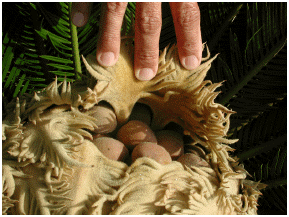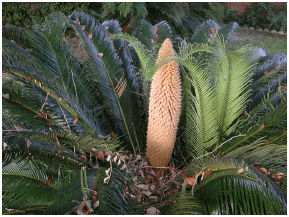IMPORTANT NOTICE: Master Gardeners are moving from Pleasant Hill to Concord. The Pleasant Hill location will be closed starting Thursday, 7/26. We hope to reopen in Concord on Monday, 8/6. Our new address and phone number are below:
Address as of 8/6/18:…
2380 Bisso Lane…Concord, CA 94520
UC Master Gardener Program Help Desk
Monday-Thursday, 9:00 AM - 12 Noon
Tel: (925) 646-6586
Phone as of 8/6/18:
Tel: (925) 608-6683
Help for the Home Gardener from the Help Desk of the
UC Master Gardener Program of Contra Costa County
Client's Request: I have recently received a potted Sago Palm as a gift. I find it very interesting with its rather odd and unique features. I'd like to know more about growing it and possibly propagating it. Can you give me some guidance? Thank you.
Help Desk Response: Thank you for contacting the UC Master Gardener Program Help Desk with your questions about your Sago palms Cycas revolute
Your sago palm is actually not a true palm at all, but a coniferous plant called a cycad. The plant produces cones and bears attractive, palm-like feathery foliage making it very similar looking to palms and tree ferns. What you could be seeing on your plant are actually cones and the growing point for future leaf production is right under the cone. If you are extremely careful, you can remove the cone. However, it is probably better to wait until the cone matures and falls apart to avoid damaging the growing point.
The sago palm is slow-growing and long-lived and your plant may not bloom (or produce a cone) in the first 15 years of its life or even ever at all. Some reference material indicates that it can be 30 years to maturity. Cycads are dioecious. A dioecious plant is one where the male and female reproductive systems occur on separate plants. When the sago plants have sexually matured, the female sago begins to flower producing a basketball-sized structure. The male sago produces a long thick structure, or the male cone. In order for the female plant to produce viable seed, it must be pollinated by a male sago palm. If you are lucky enough to have both a mature male and a female plant, this will not present a problem for you. The pollination can be achieved by the wind or insects, but you can get in the act and ensure pollination by dusting pollen from the male to the female flower yourself. You can tell when the female flower is ready to be pollinated as it will slowly open up. This usually happens in this area in the late spring to early summer. Be patient. Sago palms grow slowly and their seeds develop slowly as well.
Propagating Sago Plants: 

How to Plant Sago Palm Seeds: Sow ripe sago palm seeds in a shallow flat or pot with a soil mixture containing lots of sand. Keep temperatures in the high 70's. Months can pass before tiny shoots begin to show, and another 3-6 months or more before seedlings can be moved or repotted. Seed germination takes many months, growing them to full size can take many years.
Side Shoots and Sago Bulbs or Pups: Mature plants sometimes develop bulbs or side shoots on the stem. These bulbs can be cut off and rooted. Remove leaves from the side shoots as they pull lots of moisture. Stick the “bulbs” in soil keeping the mixture on the dry side until new roots form over a few months.
The links below lead to detailed information about Cycad care and seed germination from the Palm and Cycad Society of Australia:
http://www.pacsoa.org.au/wiki/Cycad_Seed_Germination…
http://www.pacsoa.org.au/wiki/Category:Cycad_Articles……
This link contacts information from UC about Sago Palms in the Landscape: https://anrcatalog.ucanr.edu/pdf/8039.pdf……
I hope this information is helpful to you. Good luck with your interesting plants!
Editor's Note: Large sago palms, especially in pots, can be quite valuable. You should consider protecting them from theft, especially if they are in pots. Collectors often micro-chip their sago palm to facilitate recovery if stolen.
Help Desk of the UC Master Gardener Program of Contra Costa County (SLH)
IMPORTANT NOTICE: We are moving from Pleasant Hill to Concord. The Pleasant Hill location will be closed starting Thursday, 7/26. We hope to reopen in Concord on Monday, 8/6. Our new address and phone number follow:
UC Master Gardener Program of Contra Costa County
University of California Cooperative Extension…
Contra Costa County
Address as of 8/6/18:
2380 Bisso Lane
Concord, CA 94520
UC Master Gardener Program Help Desk…Monday-Thursday, 9:00 AM - 12 Noon…
Tel: (925) 646-6586…
Phone as of 8/6/18:
Tel: (925) 608-6683
Email address: ccmg@ucanr.edu
Website: http://ccmg.ucanr.edu
Find us on Facebook: www.facebook.com/CoCoMasterGardeners…